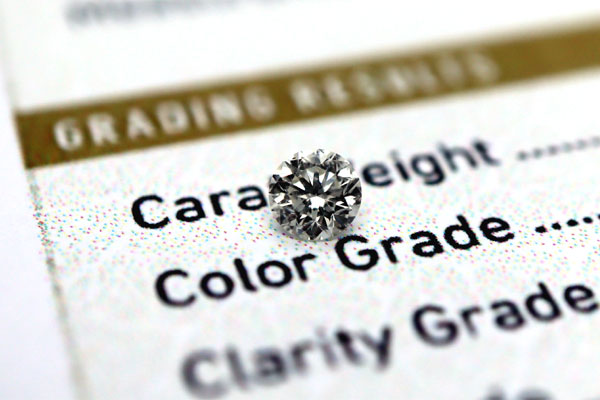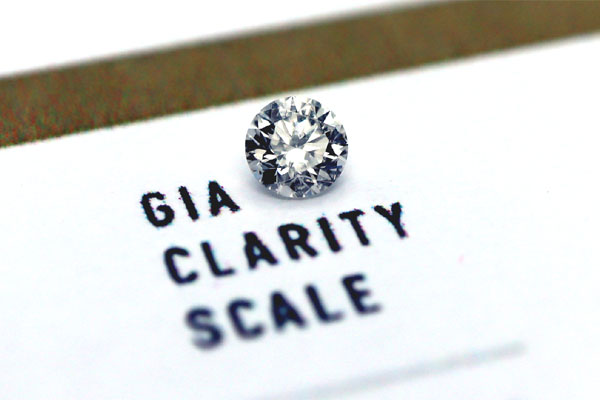Diamond Cut Grade – Everything You Need To Know
Cut is arguably the most important of the 4 C’s as it has a huge impact on how good (or bad) a Diamond looks.
And in the guide, I will cover everything you need to know about Diamond Cut but if you don’t want to read everything, here are they key points:
What Are The Diamond Cut Grades?

The most commonly used grading system for Diamond cut is the one that was released by the GIA in 2005, following 15 years of research and includes 5 grades, which are:
- Excellent
- Very Good
- Good
- Fair
- Poor
But how does the GIA assign a Diamond one of these cut grades?
Diamond Cut Grade (Proportions)
When it comes to giving a Round Brilliant Cut Diamond a Cut grade, the GIA does this based on the following 5 factors:
- Brightness – this is how much white light is reflected both internally and externally from the Diamond
- Fire – this is how well the Diamond disperses light into the colours of the rainbow
- Scintillation – this is a combination of how much sparkle the Diamond has and the pattern of light and dark areas within the stone, which are caused by reflections
- Weight Ratio – this is the comparison of the Diamonds diameter to its weight
- Durability – this is the potential risk of damage to the Diamond as mostly focused around the girdle (thin girdles are more likely to get chipped)
Each of these factors are given individual grades of Excellent to Poor.
The stone’s overall Cut grade is based on the lowest grade given to any of these 5, for example:
- A Diamond could have excellent brightness, scintillation, weight ratio and durability but it only gets a good grade for fire, then the overall cut grade for that Diamond will be good
If you are wondering how this is assessed, labs like the GIA use a combination of 3D scanning and visual inspections by trained Diamond graders.
The Proportions of a Diamond
The 5 grading factors I mentioned above are all based on the proportions of a Diamond and there are 10 of these in total
- Table size
- Crown angle
- Crown height
- Pavilion angle
- Pavilion depth
- Star facet length
- Lower girdle facet length
- Girdle thickness
- Culet size
- Total depth percentage
And on a Diamond grading report, you will probably have something like the image below that shows all the measurements of that stone.

But how do these measurements and angles impact how much a Diamond sparkles?
Before I get into the proportions, there are 2 things I need to cover:
1: Excellent vs Ideal Cut Diamonds
If you are looking for Diamonds, it can be confusing when it comes to Cut as seemingly every online retailer has their own special or exclusive cut that they often position above the GIA excellent cut.
And while some have slightly and in most cases it is a very slight difference in optical performance (so small you might not even notice with the naked eye), they will all have the same excellent cut grade from the GIA.
2: Average Girdle Diameter
The average girdle diameter is barely mentioned and doesn’t appear on a Diamond report but it is one of the most important measurements!
It is important because very few Round Brilliant Diamonds are actually truely round, they are usually slightly longer in one direction (not generally visible to the naked eye as it can be as small as 0.01mm).
It is against the average girdle diameter that the percentages for the:
- Table size
- Total depth
- Crown height
- Pavilion depth
Are calculated, for example if a Diamond has a table size of 58%, it means the table is 58% the size of the total average diameter of the stone (it is calculated by measuring north to south, east to west and then the two diagonals and then averaged).
Poor proportions are smaller or greater than Fair ones, which is why I haven’t included them in the tables below.
Table Size, Crown Angle and Crown Height
| Excellent | Very Good | Good | Fair | |
|---|---|---|---|---|
| Table Size | 52% – 62% | 50% – 66% | 47% – 69% | 44% – 72% |
| Crown Angle | 31.5° – 36.5° | 26.5° – 38.5° | 22° – 40° | 20° – 41.5° |
| Crown Height | 12.5% – 17% | 10.5% – 18% | 9% – 19.5% | 7% – 21% |
I’ve put these three together as they are very closely linked with each other, as they all play an important role in:
- The amount of fire a Diamond has, which is how much light is dispersed by the crown facets (the rainbow colors that can be seen)
- The amount of brilliance a Diamond has, which is the amount of light that is returned to the eye (depending on the pavilion)
And generally, the size of one proportion will affect one or both of the others, as you will see below.

Ideal Table Size, Crown Angle and Crown Height
With all three being ideal, it balances the amount of fire and brilliance, which gives the stone that sparkle that we expect to see in a Diamond.

Larger Table
If a Diamond has a large table then it will generally have:
- A steeper crown angle to have a good crown height or
- A good crown angle but shallower crown height
These are often known as Spread Stones as they have been cut to make them look larger than the carat weight would suggest but due to the large table, they return more light but less fire and can look a bit lifeless.

Smaller Table
Diamonds with small tables, will generally have:
- A deeper crown height to have a good crown angle or
- A shallower crown angle but a good crown height
This is commonly found in Old Cut Diamonds and the stones can show a lot of fire but might not look very bright due to less light being returned from the stone.
Pavilion Angle and Pavilion Depth
| Excellent | Very Good | Good | Fair | |
|---|---|---|---|---|
| Pavilion Angle | 40.6° – 41.8° | 39.8° – 42.4° | 38.8° – 43° | 37.4° – 44° |
| Pavilion Depth | 43% – 44.5% | 41.5% – 45.5% | 40% – 46.5% | 38% – 48% |
I’ve put these in the same section, as once again, they are directly related to each other.
The pavilion proportions are arguably the most important proportions of a Diamond as they determine how light is reflected within the stone.
The pavilion facets act like mirrors and the aim when cutting a Diamond is to reflect the light off the pavilion facets in a way that returns the maximum amount of light to the person looking at the stone, this is also known as Total Internal Reflection (TIR).
Ideally, every Diamond would do this but it isn’t always the case, due to cutting errors, trying to remove inclusions (to get better clarity) or trying to maximise yield, some Diamonds end up with pavilions that are shallower or steeper.
The result of this is that light leaks out of the Diamond and not only can this reduce the amount of fire and brilliance within the stone but can also produce some undesirable visuals.
Shallow Pavilion

Ideal Pavilion

Deep Pavilion

As you can see from the three images above, a stone with an ideal pavilion angle/depth returns the most light to the person looking at the stone and importantly, the light hits the crown facets at the correct angle which causes the light to disperse, which creates the fire.
With the shallow and deep Diamonds, light is leaking out of the stone and because if this they may appear darker than well-cut Diamonds.
But what about the undesirable visuals I just mentioned?

Fish-eye in Shallow Diamonds
The first is known as a fish-eye and this occurs in shallow Diamonds and is caused by the girdle being reflected in the stone.
This looks like a white ring that is visible through the table (I used a gray circle as white doesn’t show up very well!) and the shallower the stone, the more noticable it becomes.

Nail Head in Deep Diamonds
For deep Diamonds, they have what is called a nail head, as the area under the table appears very dark.
This gets bigger the deeper the Diamonds get, with the Diamond showing what it would look like on quite a deep stone.
Girdle Thickness
| Excellent | Very Good | Good | Fair | |
|---|---|---|---|---|
| Girdle Thickness | Thin – Slightly Thick | Very Thin – Thick | Extremely Thin – Very Thick | Extremely Thick |
The girdle thickness is another important proportion but not so much in terms of how the stone looks as some of the ones mentioned above but more in terms of durability and how heavy the stone is in relation to its diameter.
Girdle thickness can range from extremely thin (sometimes called a knife edge) to extremely thick and the extreme ends of the scale are to be avoided because:
- Extremely thin girdles can be easily chipped or damaged, which is a durability issue
- Extremely thick girdles can add weight to the stone
Very thick girdles can also cause light to leak out of the stone, which does have a negative impact on the look of the stone but not to the extent of table size, crown or pavilion angles.
Total Depth
| Excellent | Very Good | Good | Fair | |
|---|---|---|---|---|
| Total Depth | 57.5% – 63% | 56% – 64.5% | 53% – 66.5% | 51.9% – 70.9% |
The total depth is the depth of the Diamond in relation to the average girdle diameter and if a Diamond has a total depth within this ideal range, it can increase the chances that the:
- Crown height
- Pavilion depth
- Girdle thickness
Fall within the ideal ranges for their respective proportions but this isn’t always a guarantee.
Culet Size
| Excellent | Very Good | Good | Fair | |
|---|---|---|---|---|
| Culet Size | None – Small | None – Medium | None – Large | None – Very Large |
The culet is the name for the facet at the very bottom of a Brilliant Cut Diamond but the majority of Diamonds either don’t have one (the pavilion facets meet at a point) or a very small one that is very difficult to see with the naked eye.
But some Diamonds will have a noticeable culet and this isn’t ideal as it can create a small ‘window’ in the stone, which means that the light is passing straight through the stone rather than being reflected back out of the table.
It is very common to see Old European and Mine Cuts with a very large culet.
Star Facet Length
| Excellent | Very Good | Good | Fair | |
|---|---|---|---|---|
| Star Facet Length | 45% – 65% | 40% – 70% | Any Length | Any Length |
A relatively recent addition to Diamond cut grading is the length of the star facets as being too long or short can impact the way that light interacts with the Diamond.
The size of the star facets is measured as a percentage of the distance between the girdle and the edge of the table.

Lower Girdle Facet Length
| Excellent | Very Good | Good | Fair | |
|---|---|---|---|---|
| Lower Girdle Facet Length | 70% – 85% | 65% – 90% | Any Length | Any Length |
As with the star facets, the size of the pavilion facets or lower half facets as they are also called is now a part of the cut grading process as if these facets are too long or short, then impact on how the light interacts with them, which can have an impact on how the stone looks.
The length of the pavilion facets is measured as a percentage of the distance between the girdle and the culet of the stone.
Diamond Symmetry

A Diamond’s symmetry is graded separately from the cut quality and all Diamonds submitted for grading will be given a symmetry grade, regardless of the shape of the stone.
The easiest way to describe symmetry is to look at the stone and put an imaginary line down the centre of the Diamond (this is done looking down at the stone and also looking at the side profile, like the picture) and see if the left side looks the same as the right.
There are a number of different factors that are looked at when grading a Diamonds symmetry, including:
All of these factors have an impact on how good or bad a stone looks, including its fire and brilliance as some of these impact on how light interacts with the stone.
Polish
The final factor relating to Diamond Cut is the polish and this is how good or bad the final polish of the Diamond is and all Diamonds submitted for grading will be given a polish grade, regardless of the style of cut.
The majority of Diamonds are polished to a perfect or near-perfect finish, meaning that they get an excellent or very good grade but the following factors can be the reason why a stone has a lower grade:
- Polishing lines on the facet faces
- Burn marks on the surface of the Diamond
- Areas that haven’t been polished
These polishing imperfections may be noticeable but in most cases need to be viewed under magnification to see.
What You Need To Know About Diamond Cut
It is very easy (especially as a gemologist) to talk about all the technical aspects of Diamond Cut and I hope that I’ve made this post pretty easy to follow but when it comes to buying a Diamond, there are some things that you need to know that can make the whole buying process a whole lot easier:
1. If Possible, Go For Excellent or Very Good Cut Grades
This is because these Diamonds have been graded as performing well in all the factors that are used to assess a Diamonds cut quality, meaning that the Diamond should be bright and sparkly due to having good fire and brilliance.
You should also go for Excellent or Very Good for the symmetry and polish.
2. Two Diamonds With The Same Cut Grade Can Look Different
As you will have seen earlier in this post, with each of the factors that are used to grade the cut quality of a Diamond, there are a range of parameters rather than a single set of figures for the ‘perfect’ cut Diamond and this means that you can have two Excellent Cut Diamonds that look different when viewed side by side.
This is part of the beauty of Diamonds as each one is unique and has its own characteristics.
Conclusion
The cut quality of a Diamond is so important and could be argued that it is the most important of the 4 C’s as it has such a big impact on how good the Diamond looks and after reading this, you will have learned that:
- Currently, only Round Brilliant Diamonds are cut-graded
- The proportions of a Diamond impact on how the stone interacts with light
- The symmetry and final polish of the Diamond are also quality factors
And if you are buying a Diamond, then cut quality should be considered just as you would color and clarity as combined, they have a big impact on how your Diamond looks.
I'm Paul Haywood FGA DGA, the owner and founder of Haywoods Gems, I'm a fully qualified Gemmologist and Diamond Grader from the Gemmological Association of Great Britain.







